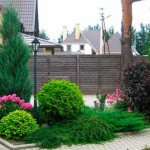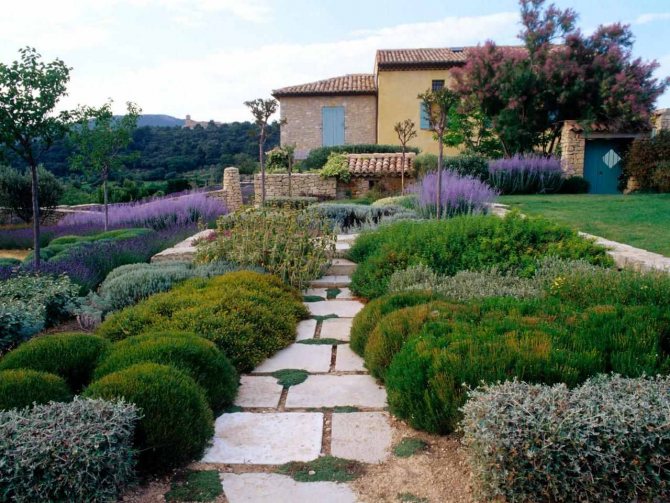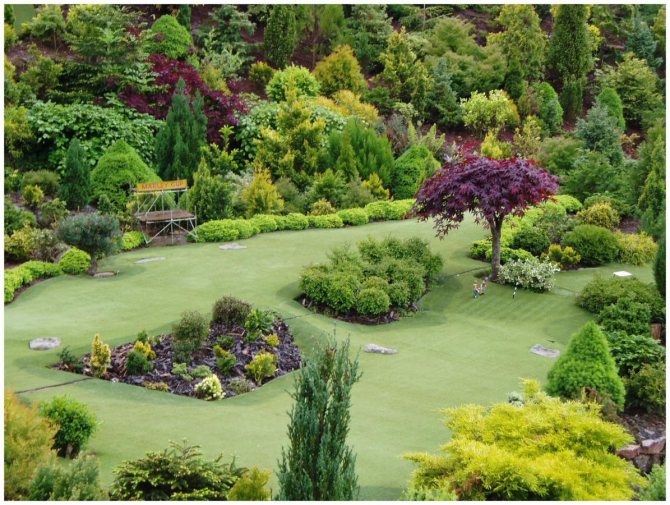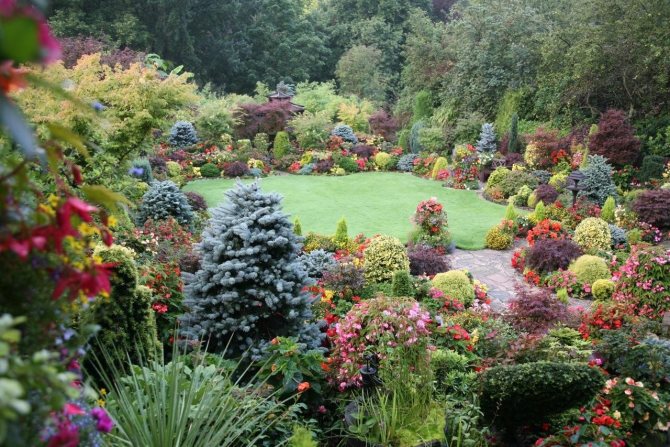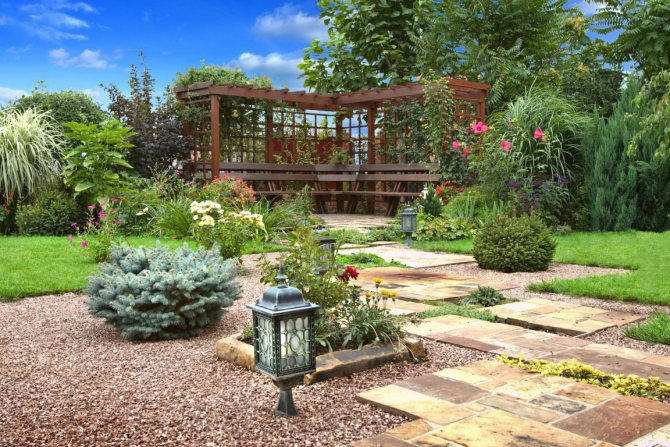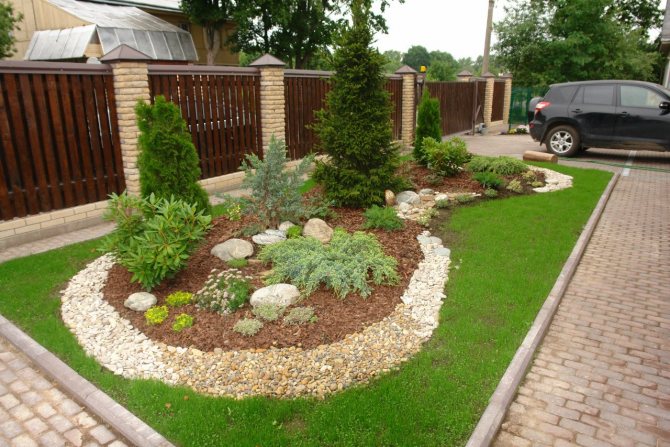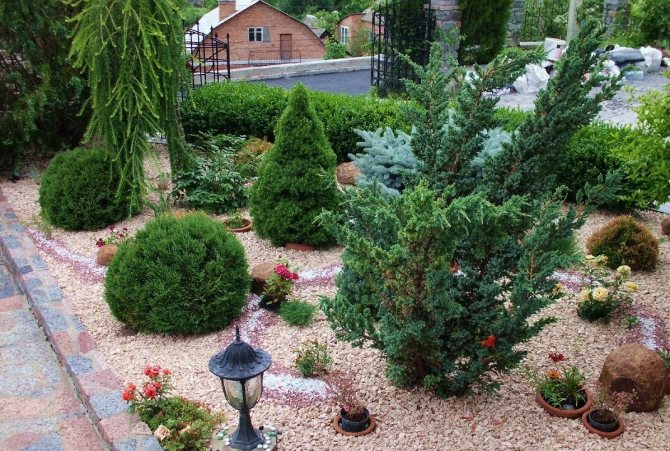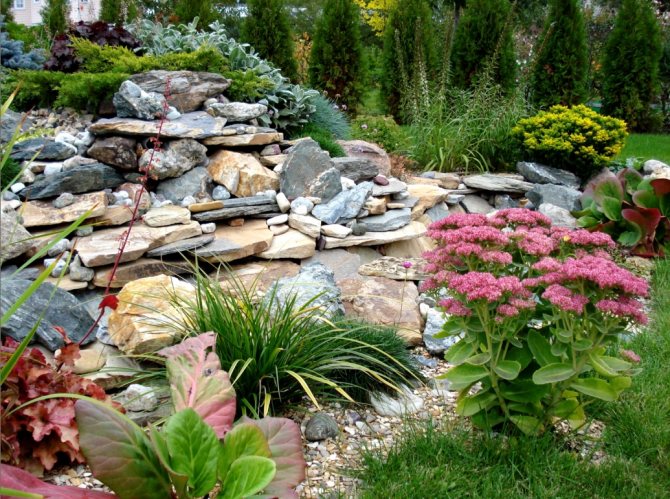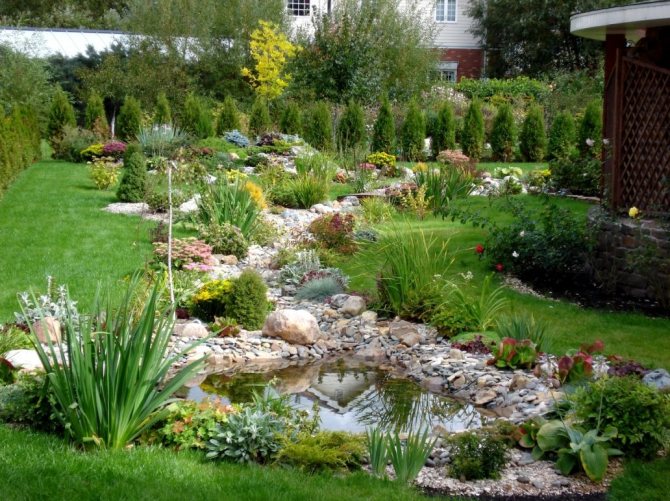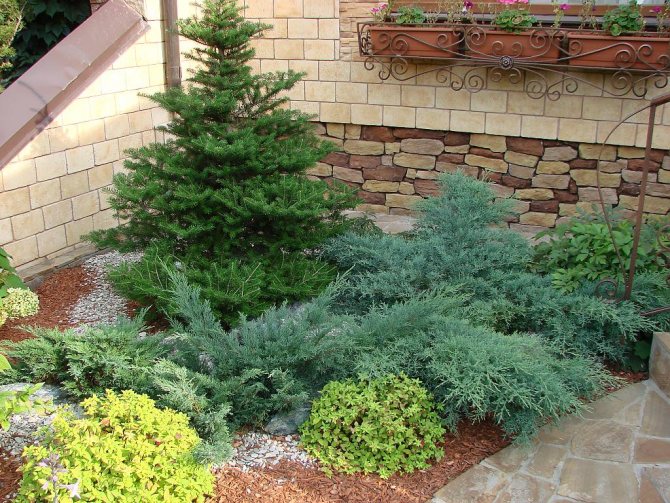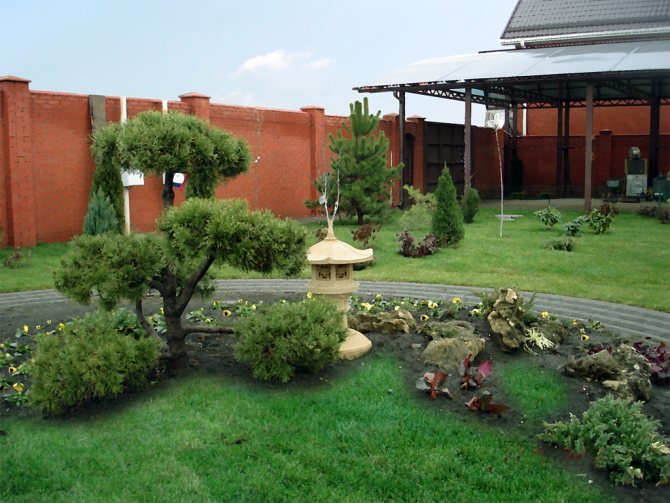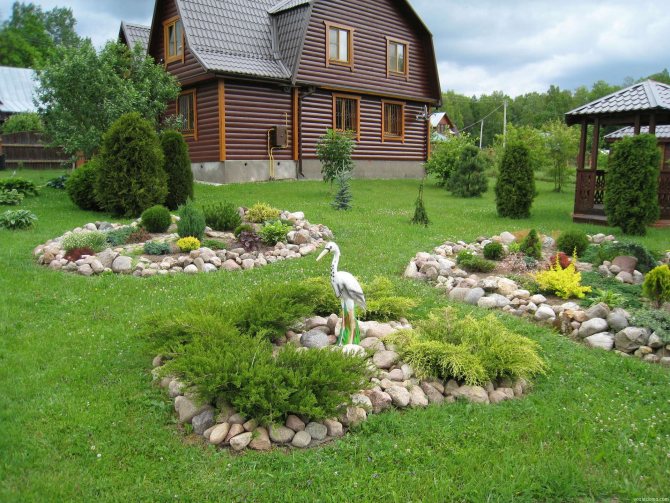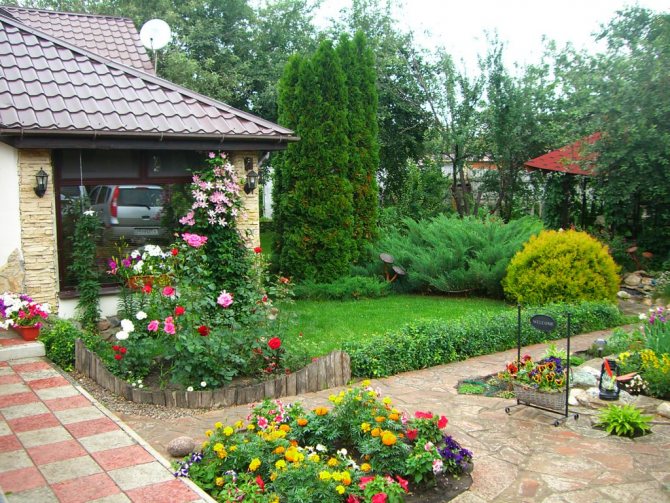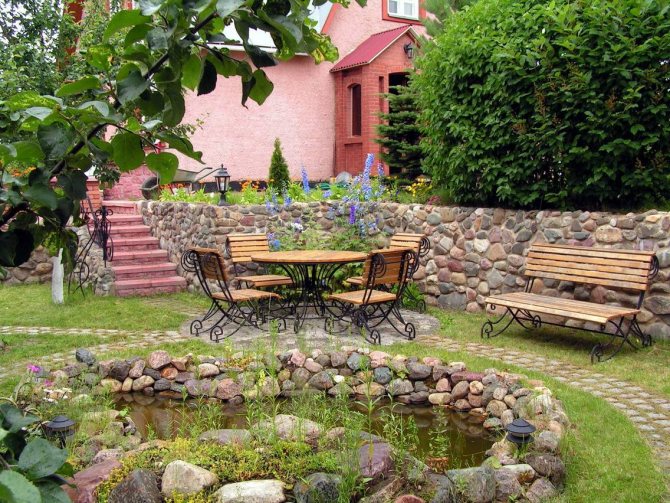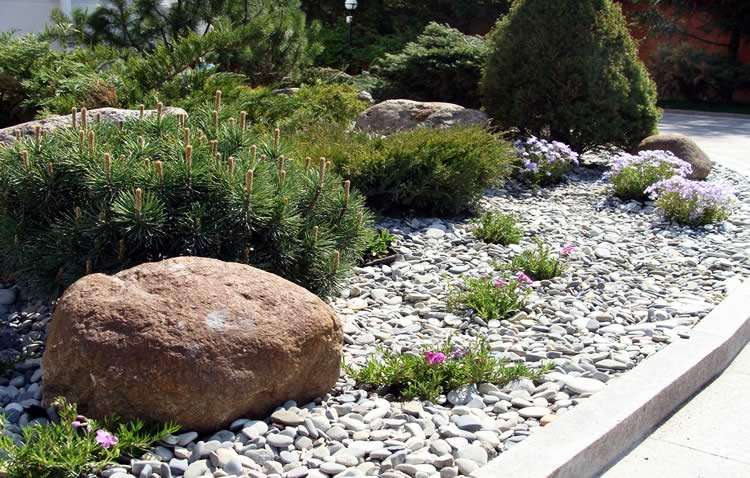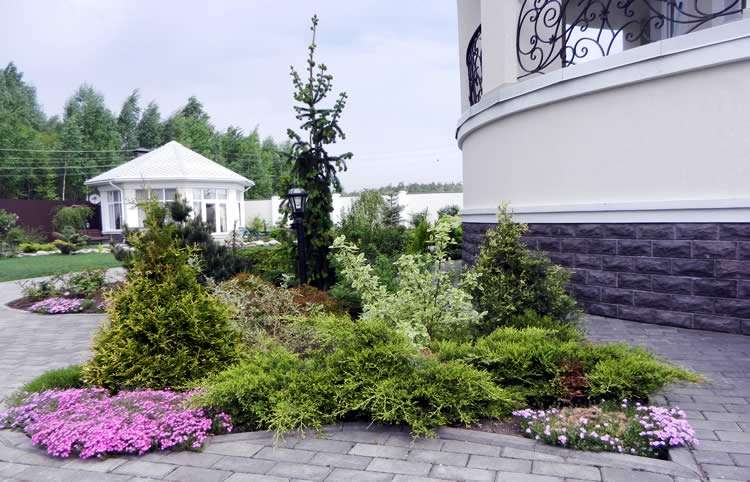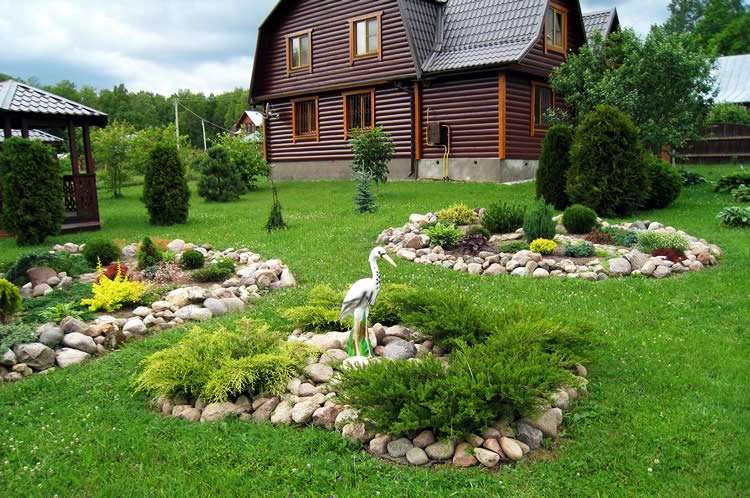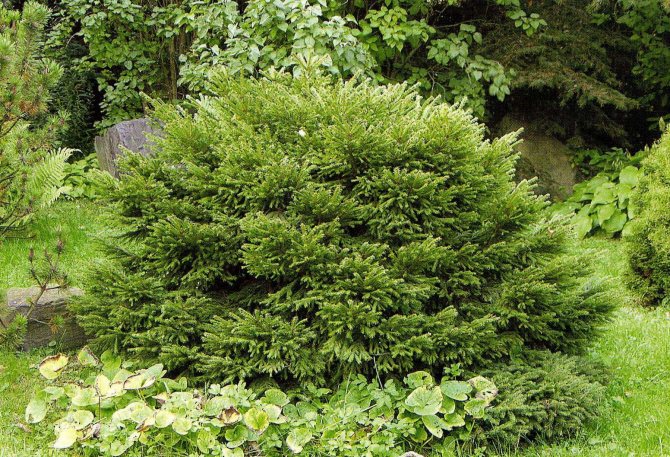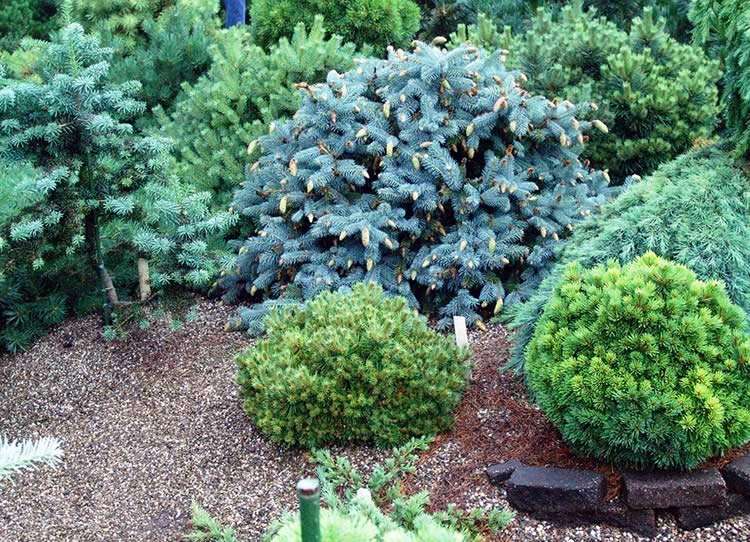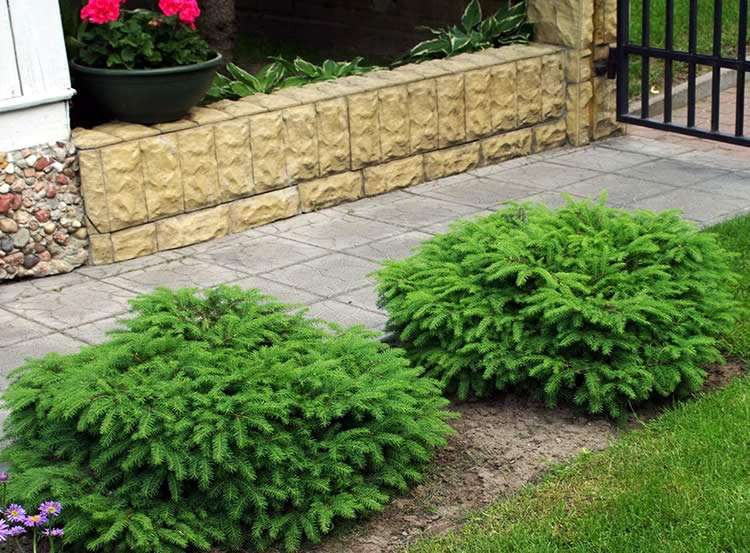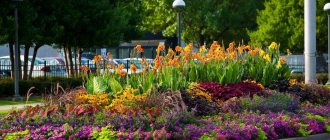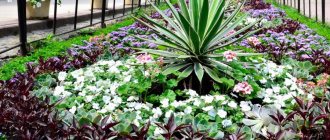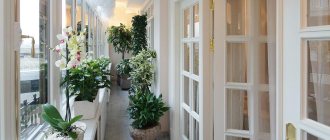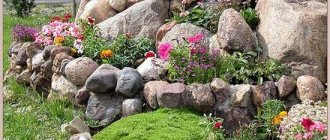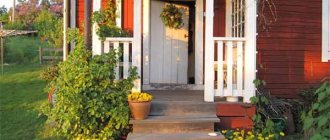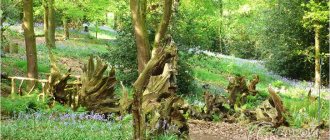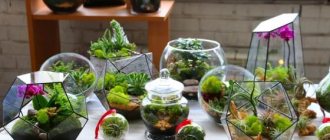- Coniferous mixborders design rules
- Layout options for a coniferous mixborder
- Coniferous mixborder: site selection and step-by-step site preparation
- Seasonal care of a coniferous mixborder
- Video: how to create a coniferous mixborder
Coniferous mixborder - a purely English invention. The British decorated garden paths with elongated flower beds, marked the boundaries of plots, and decorated hedges. In such compositions, the basis is made up of perennials: low conifers and various shrubs, annuals are only an addition. In compiling a mixborder, they adhere to certain schemes and tiers.
Features of mixborders with ephedra
At their core, mixborders are complex flower beds of continuous flowering, which, with a competent approach, make it possible to enjoy them throughout the year. In general, any conifers can be used to equip a mixborder, but for harmony it is better to give preference to plants with a height of no more than 1.5 m.If you neglect this recommendation, then tall plantings will stand out strongly from other crops. Among the positive aspects of using conifers to create a mixborder, experienced landscape designers note:
- Relative ease of content. Plants are distinguished by their ability to get along well with other plants. It is enough at the very beginning to correctly determine the landing site and prepare the site in order to exclude any difficulties in care in the future.
- Long-term preservation of high decorative characteristics (throughout the year). Not only in the warm season, the coniferous mixborder retains its attractive appearance, but also in the cold - it looks fresh and bright.
- To make mixborders with conifers beautiful, there is no need for significant labor costs. The mixborder with conifers has a neat look, does not need frequent shaping pruning, and even beginner growers can keep fit.
- A mixborder with the use of conifers looks equally effective both in a monochromatic version and in a contrasting one. The needles with a bright green or emerald-bluish color in combination with green shrubs and lush summer plants look especially luxurious.
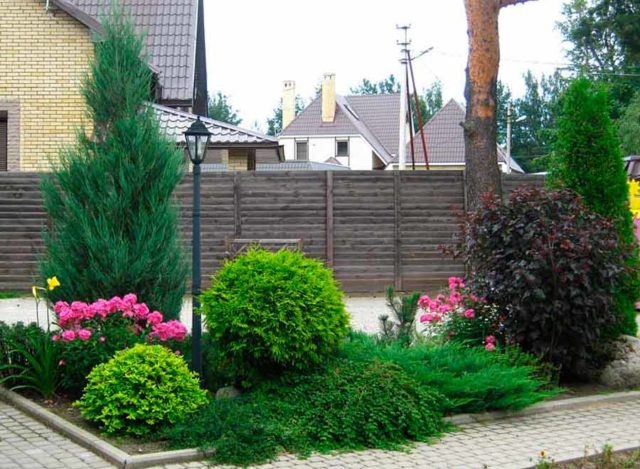
One of the main features of coniferous mixborders is the ability to look in a winning light in any landscape design. Such combined flower beds are also found in gardens made in the English, Chinese style, in forest compositions. It is noteworthy that such a solution as a mixborder can not only be a worthy decoration of the local area, garden, but also a kind of delimiter of space. They are especially often used to decorate high fences, blank walls, desert areas, and also highlight the line of the garden path.
What plants are suitable for a mixborder?
The basis of the evergreen flower garden is made up of "skeletal" plants that set the rhythm and character of the entire composition. Conifers are ideal for this role, attracting with their solemn elegance at any time of the year.During the period of general flowering, conifers become a worthy background for ornamental shrubs and flowers, and in winter they draw all the attention to themselves and look like a separate, completely finished design solution.
The most popular for creating a mixborder include the following dwarf conifers:
- They ate with needles of normal and blue color;
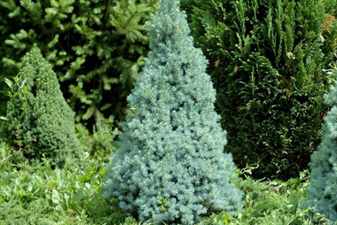

- Lawson's cypress is a spectacular tree with round cones;
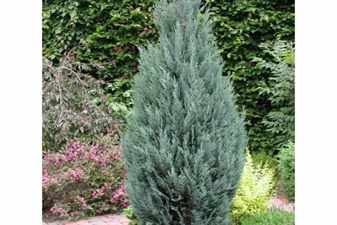

- Korean fir, the needles of which shine with silver, and the cones of an unusual purple color;
- Bergman Pine is a curly coniferous beauty. Photo:
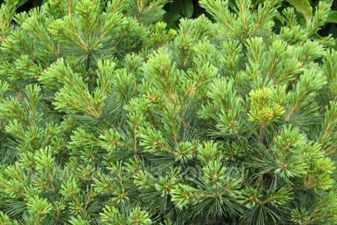

- Mountain pine;
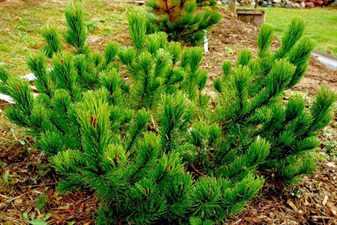

Low maintenance juniper with creeping branches. The photo:
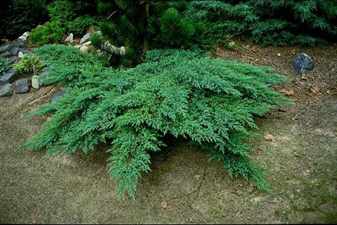

- Fan-shaped branches of yew, decorated with red berries, are very decorative and always admire
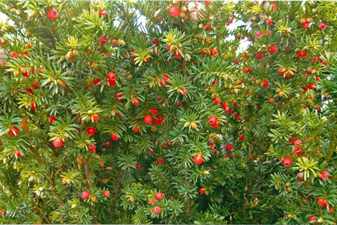

- Weeping larch will add a special charm to the composition
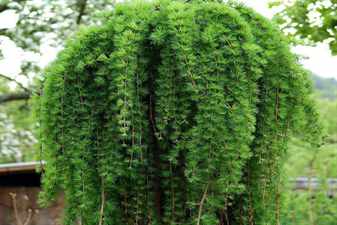

Conifers - columnar, spiral, spherical, creeping - amaze with their richness of forms and give room to the imagination, allowing you to create a unique mixborder.
What conifers to choose
The main rule when choosing plants for coniferous mixborders is to use low specimens with compact sizes - up to one and a half meters in height. If the plantings are too high, voluminous, then they will not only overshadow the planted ornamental crops, but also begin to create inconveniences in their further maintenance. You can consider them as components of a coniferous mixborder, but only in small quantities. When arranging a coniferous mixborder, the factor of getting along with other plants should be taken into account so as not to provoke competition between plantings.
Here is one of the best options for a coniferous mixborder:
- dwarf spruce;
- creeping juniper bushes;
- undersized thuja, fir, pine.
Important! To achieve the desired result when choosing plants for coniferous mixborders, you need to take into account the width of growth of specific specimens and the presence of difficulties in care. It is better to give preference to plants with the same requirements for keeping conditions.
Plant compatibility
Some conifers, despite their unpretentious nature, do not coexist well with each other and deciduous plants. And before planting the composition, it is worth learning about the characteristic features of the cultures:
- Spruces and firs coexist well with each other, but they do not take root well with pines and cedars.
- Birch and bird cherry extract from the soil the nutrients necessary for the normal growth of evergreens. Therefore, they should not be planted nearby.
- Larch does not tolerate the neighborhood with any coniferous plants.
- Thuja should not be planted next to a spruce. This slows down their growth.
Consider these rules before making your landscape design project.
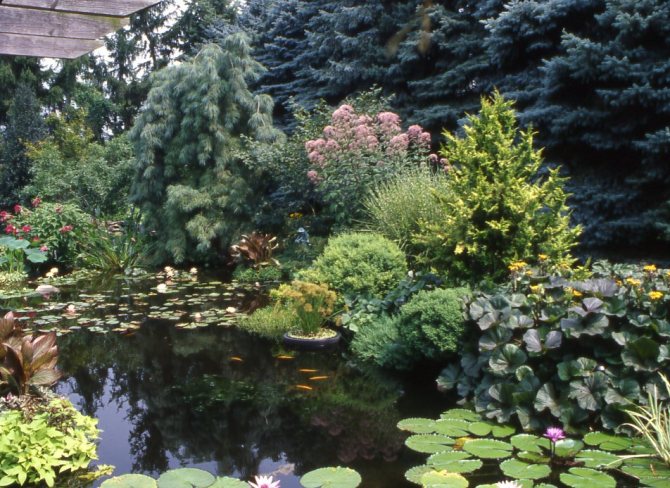

Types of conifer mixborders
Coniferous plants themselves already have a presentable appearance, they also look great as separate decorative elements of the garden. But for greater effectiveness, it is better to dilute evergreens with deciduous shrubs, perennial flower crops. It is important to follow the rules for creating a mixborder.
Mixborders of conifers and shrubs
The sharing of conifers and deciduous shrubs is a classic of the genre. In most cases, a mixborder of their conifers and shrubs is made along the fence, near outbuildings as a hedge to protect the local area from prying eyes.
Often, coniferous stands in a mixborder act as a "frame, skeleton" for it, defining both the outline and height. It is best to identify them in the background of a mixborder located near a wall or fence. If the combined composition is in the middle of the free space, then it is recommended to plant ephedra in the center.When choosing plants for decorating the lower tier, it is worth considering shrubs such as elderberry, magnolia, hibiscus, lilac. When a mixed flower garden is created, the growth rate of deciduous shrubs is taken into account in order to prevent them from rising above conifers.


There is another rather interesting design option for the English mixborder - the main role is assigned to deciduous shrubs, and the secondary role is given to the representatives of the conifers, which are placed on the lower tier. A creeping juniper will look great here, the height of which in adulthood rarely exceeds 1 m.Plants should be planted in a mixborder with some interval between them in order to further exclude a lack of sunlight. With a dense, improper planting, plants in a flower garden will experience not only a lack of lighting, but also suffer from stagnant moisture, since the aeration qualities of the soil will deteriorate.
Coniferous and perennial mixborders
Another type of mixborder is still highly popular - a flower bed consisting of bushes of juniper, pine, fir, and other plantations in tandem with flowering perennials, herbaceous plants. The indisputable advantages of such mixborders are:
- Pretty attractive look. Against the background of evergreen conifers, flowering perennial plants occupy the most advantageous position. They are in perfect harmony with specimens of delicate pastel shades or rich colors. With this arrangement, perennial conifers in the mixborder immediately draw attention to themselves. The plot takes on a stylish and noble look.
- A mixborder of evergreen shrubs, trees and perennials does not lose its attractiveness throughout the year.
It is relatively easy to care for such a harmonious ensemble, conifers and perennials in a mixborder, planted along the fence, near the building, do not require a special approach. The main thing here is to timely carry out irrigation measures, loosening the soil, periodically add nutrient compositions to maintain them in a healthy and beautiful state.
Photos of coniferous mixborders in landscape design are striking in splendor.
Mixborders of conifers, flowers and shrubs
This option for arranging a mixborder near the house is somewhat difficult, but it is the best scenic option among other types of mixed flower beds. Such a multicomponent composition is used, where conifers, deciduous shrubs, and flowers are involved for the spectacular design of large free areas, since a rather large area must be allocated for them.
Here they equip 3 tiers, where the main role is assigned to evergreen or deciduous shrubs, depending on the height of the specimens used, complemented with flowers. There are several guidelines for designing a composite composition:
- Tall plantings are defined in the center if the mixborder is double-sided, and in the background - when arranging near a fence, a wall.
- The second tier in the mixborder will be planted with specimens that stand out for their average height. Thus, it is possible to make a beautiful and gentle transition from tall to low-growing plants.
- Perennial flowers are placed on the lower tier of the mixborder, attracting eyes with their bright colors and high decorative qualities. So the mixborder takes on a complete look.
The use of three-tiered mixborders becomes especially relevant when arranging uneven areas of the garden. It is thanks to the peculiarities of the alpine hills, where each tier is clearly expressed, that it is possible to effectively design any unpresentable corner of the local area, the coastline. Most often, this method of decoration is resorted to when decorating the coastal zone near artificial reservoirs, where there are serious differences in height.
Important! When designing an English mixborder, you need to correctly prioritize so that the planted evergreen trees, shrubs and perennial flowers do not overlap each other, but at the same time do not emphasize sudden changes in height, completely occupy all the available space.
So, an interesting option for a mixborder of coniferous and ornamental shrubs, flowers is a flower bed of tall spreading bushes of elderberry or lilac, tall phlox or delphiniums (middle tier) and creeping ground cover conifers (lower tier).
Photo of a mixborder of conifers and shrubs using also perennial flowers.
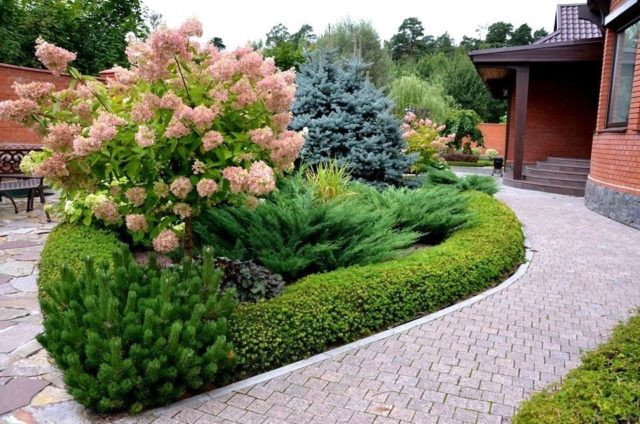

9
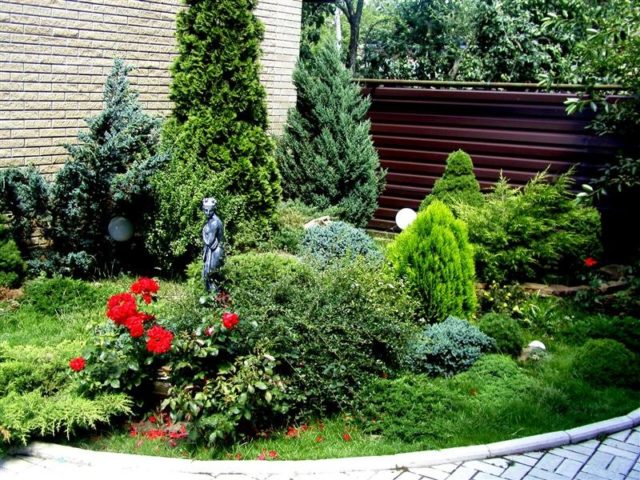

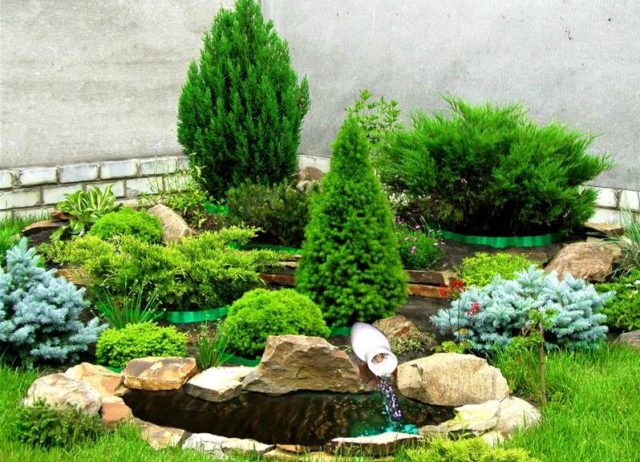

How to start planting a mixborder flower bed?
Before starting to work with the ground, it is necessary to draw up a diagram of the future masterpiece in order to accurately determine the boundaries of the flower bed. Whatever the chosen place, when planting perennials, the following conditions must be observed:
- Mixborders plant row by row: the lowest elements of the composition are in the foreground, the middle row is shrubs up to 60 cm, the highest, from a meter or more, in the background, if the flower bed is long, for one-sided viewing.
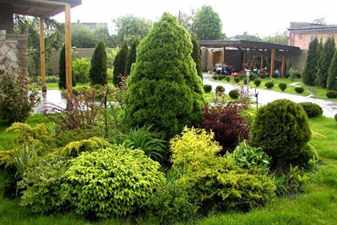

2. When calculating the area required to create a composition, it should be taken into account that large plants need at least 1 m2, average about 0.6 m2, and undersized at least 0.3 m2 for full development and harmonious neighborhood as the plants grow.
3. It does not matter where exactly it was decided to set up a grandiose flower garden: near the house, in the center of the lawn or along the fence - ready-made schemes will help determine the choice of plants and the preparation of the site for planting work.
Soil preparation within the designated contours of the composition is reduced to digging, cleaning the soil from weeds, loosening, and applying fertilizers.
The site must be divided into three conditional zones for tall, medium and low-growing plants, according to the chosen scheme, determine the place for each plant and the size of the free space around for growth in the future and subsequent care of the seedling.
For clarity, you can place the seedlings in the places intended for them, in order to once again be convinced of the perfect harmony of the chosen version of the flower bed.
Choosing a place for a coniferous mixborder
To equip a flower garden of free outlines, as gardeners also call mixborders, you need to correctly determine the place. To do this, you should evaluate:
- soil composition (degree of fertility, moisture and air permeability);
- humidity level;
- the degree of illumination.
In order to avoid the appearance of such negative consequences as burnout of needles under the influence of direct sunlight, it is better to choose glades where sunny and shadow periods replace each other during the daylight hours. Brightly lit areas are not suitable for all ornamental crops. In addition, you should not consider areas where there are through winds, plants should be protected from cold air.
As for the soil, it should not be with an excessive level of moisture, too dry soil is also of little use for creating a mixborder. If you plant plants in a swampy area, then there is a high probability of decay of their root system, which will soon lead to their death.
If there is a desire to effectively arrange a hedge with the help of a coniferous mixborder, then you should not place plants near windows, when they begin to grow, the view will deteriorate. Solid stripes are also not recommended; it will be more aesthetically pleasing to divide it into several zones. In addition, it will be much easier and more convenient to take care of. It is advisable to retreat 50 cm from the edge of the garden path.
Advice! When compiling an English mixborder, it is recommended to combine plants with warm colors with specimens of the same warm colors, and cold ones with cold ones.The presence of conifers in a complex flowerbed adds moderate severity and restraint to it, which only emphasizes the sophistication of the flower arrangement.
Regardless of the location, the plants in the mixborder should be planted in rows. In the foreground, there should be specimens with a height of up to 40 cm, the second tier should be crops with a height of up to 60 cm, and it is better to decorate the third tier with plants with a height of 100 cm.
Tui in the country: we plant beautifully and correctly
In principle, thuja is an unpretentious plant. In order to calmly grow and develop, she needs a sunny location. However, partial shade is also quite a suitable place. The main thing is not to plant thuja on the north side. The rest of the world is entirely suitable for this shrub.
If you decide to plant thuja with a hedge, be sure to ask the garden center consultant about how much the varieties you have chosen grow in height and breadth. This will allow you to maintain a competent distance when planting, so that the trees in the future do not interfere with each other, and the “fence” of thuja looks perfect.
If you want to create a beautiful hedge out of several thujas, take a look at the Columna variety: these varietal conifers grow straight up and quickly turn into beautiful columns.
Another variety - "Smaragd" - is also great for creating hedges. In addition, if you remember, this is the same variety that goes surprisingly well with rose bushes, so you can safely use it as a background for rose plantings. Before planting "Smaragda" we recommend that you pay attention to some of the features of this process.
- Distance between thuja:not less than 70 cm.
- Distance between thuja and hedge:not less than 1 m, better - 1.5 m.
It takes several years to turn into a chic evergreen hedge. About three years. The maximum height of this cone-shaped tree is six meters. The minimum is four meters. In width "smaragd" grows by 1.8 m. The soil for "Smaragda" does not matter much. The main thing is that the location assigned to this tree is not shady. Sun or partial shade are great options. The rest is not that important. Young thuja are planted already fertilized. The trees can easily withstand Ukrainian frosts.
The best of the qualities of the thuja variety "Smaragd" is the absence of a tendency to yellowness. That is, this varietal thuja does not turn yellow under any circumstances and always remains green.
Thuja are combined with roses perfectly, and we repeat this many times already. But keep in mind: if three varieties of plants participate in the ensemble you have created (for example, one varietal thuja and two varieties of roses), then there should be no more than two shades. If there are significantly more plants participating in the ensemble, you should do this: divide all plants into groups of three in each and at the same time make sure that the number of flowers in each group is no more than two.
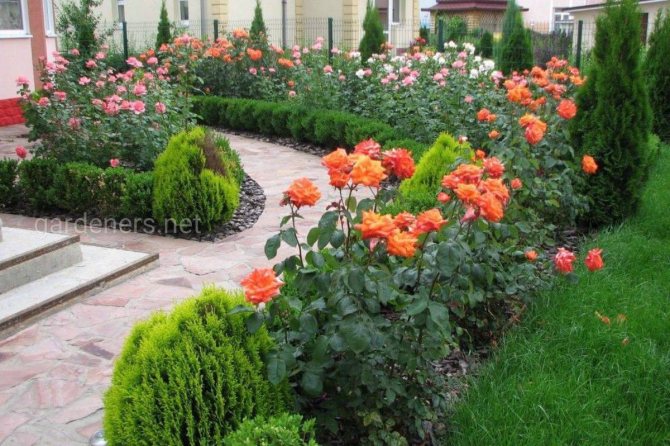

How to create a coniferous mixborder
To get the desired effect when arranging a site, you can use a ready-made mixborder scheme, or you can design it at your own discretion. This can be done either on paper or using a computer program. For convenience, you need to make a markup according to the types of plants used, assigning a different color to each culture. It is also recommended to take into account the location of decorative stones and other design elements. And do not forget about garden paths, areas for going deep into the English mixborder.
When planting plants, thickening should not be allowed, otherwise it has a depressing effect on them.Each crop should have enough free space in the mixborder; you can fill the empty spaces at the growth stage by planting annual or potted flowers. In the future, permanent plantings are planted instead.
For large specimens, it is quite normal to allocate an area from one meter, and for medium-sized forms - from 60 cm.If crops with a low degree of frost resistance are used, then for the convenience of shelter it is recommended to place them close to each other. When drawing up a combined flower garden - a coniferous mixborder, it is allowed to plant the same plants at certain distances.
Soil preparation
It is necessary to lay a mixborder after the establishment of warm weather, when the threat of return spring frosts has passed. It is quite acceptable to carry out planting work in the autumn season, the main thing is to be in time a month before the onset of cold weather. Otherwise, the plantings will not be able to take root and die.
The process of preparing sites for a mixborder itself is carried out according to the standard scheme:
- the territory is cleared of weeds;
- dig deeply (on a shovel bayonet);
- saturate with useful elements (mineral complex, rotted organic matter);
- if necessary, dilute with sand (if heavy soil);
- deoxidized with lime or dolomite flour.
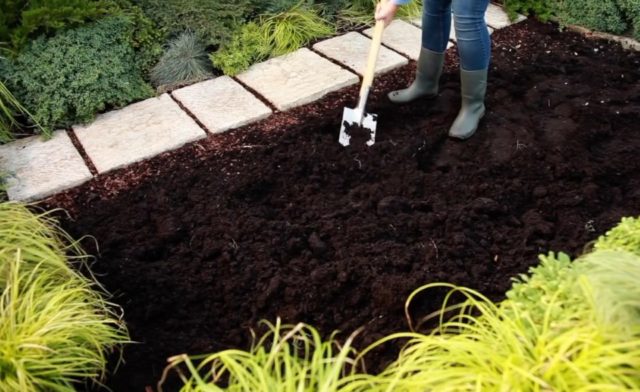

To create the most comfortable conditions for the growth and development of mountain and rocky plants, you need to use gravel or expanded clay with subsequent digging of the soil. It is quite normal for meadow perennials to be on ordinary garden soils. At the end of the preparatory work on the territory allotted for the mixborder, markings are made according to the plan.
Planting
Large plants with a height of 80-150 cm are planted first, which will form the "skeleton" of a complex-component flower bed, set its height and background. From conifers they choose:
- fir-tree Konik;
- thuyu Dannik;
- cypress;
- mountain pine Winter Gold;
- scaly juniper.
Among flowering shrubs for a mixborder, varieties such as are excellent:
- magnolia;
- hydrangea;
- jasmine;
- hibiscus.
In addition, plants such as:
- Buzulnik Przewalski;
- elecampane high;
- delphinium;
- artichoke;
- multi-grate;
- pampas grass.
In the middle of the mixborder, it is effective to plant vines and tall plants (50-80 cm), which will cover the trunks of trees and shrubs. It does an excellent job with this function:
- rudbeckia is beautiful;
- rudbeckia Golden ball;
- decorative bow;
- panicled phlox;
- peonies;
- lily;
- aconite;
- lupine.
You can also dilute the flower garden by planting pursha wormwood, Thunberg astilba, Chilean gravilate, multiflorous milkweed. Mixborders from conifers and roses look original. Thanks to this approach, it is possible to create unique combined flower beds with an English accent.
To cover the bases of the planted plants, undersized crops with bright colors or original foliage should be placed in the foreground. It is especially good to use for these purposes the Korean chrysanthemum, badan, daffodils, primrose, tulips, as well as gypsophila, lungwort. Among groundcover, the following are especially appreciated:
- phlox (subulate, splayed);
- splinter;
- woolly stachis;
- ducheney;
- creeping thyme.
If shade-tolerant plants are needed, then it is better to give preference to the creeping tenacious, hoof, periwinkle. From the long-flowering varieties, it is worth choosing purslane or sedum. Barberries are also suitable for decorating a coniferous mixborder, which are distinguished by their endurance and the ability to grow, both in sunny areas of the garden and in partial shade. Upon completion of the planting of the main components of the mixborder, annual plants such as night violets, asters, marigolds, nasturtiums, petunias are sown. The contour of the flower garden is made out with gravel, decorative stone or sand.


Mixborder schemes from shrubs, conifers and perennials
The schemes will help you arrange your own site.
Caring for coniferous mixborders
Despite the unpretentiousness of the plants used to create a flower garden, in order to maintain their decorative effect, they must be provided with appropriate care. At the stage of active growing season, weeding should be done, clearing the flower garden from problem vegetation. You can also do this in manual mode, pulling up the weeds by the roots. The use of herbicides in this case is not advisable.
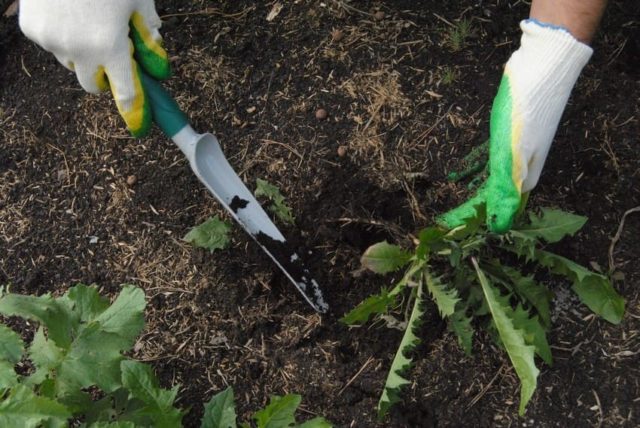

Feeding procedures are performed 2-4 weeks after planting. Nutrient formulations with a high nitrogen concentration or complex preparations must be diluted with water according to the manufacturer's instructions. In order to avoid undesirable consequences, the working solution should be poured as carefully as possible, preventing it from getting on the leaf plates of ornamental plants. Otherwise, it threatens the appearance of burns on them. Such dressings are relevant for spring, and in the fall it is effective to apply fertilizers with a predominance of potassium and phosphorus in them.


Important! You cannot overdo it with nutrient compositions, otherwise a favorable environment will be created for the development of a fungal infection, an invasion of parasitic individuals.
For better survival at the initial stage of development of the mixborder, irrigation should be carried out regularly. They are performed as the top layer of the soil dries up. In the future, when the flower bed grows up, watering is plentiful, but rare. The optimal time for these procedures is in the morning and evening, using a hose with a spray or a watering can. After each irrigation, it is advisable to loosen the soil in the mixborder.
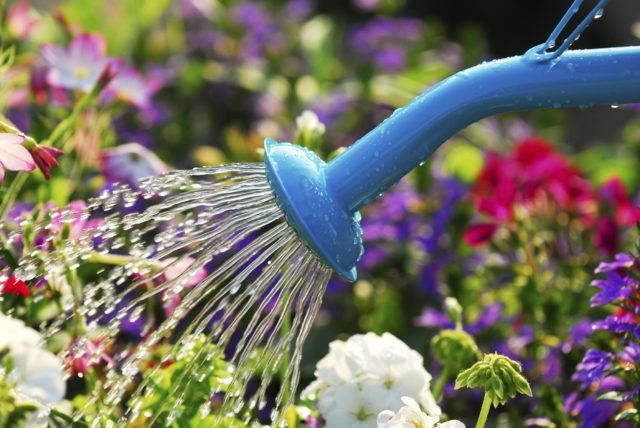

If systematic and serious violations in the care of plants are not observed, then the likelihood of damage to them by diseases and pests is minimal. As a preventive measure, you need to use a soapy solution and regularly loosen the soil, remove fallen leaves, faded inflorescences. In the case of dense thickets, adjustments should be made by pruning.
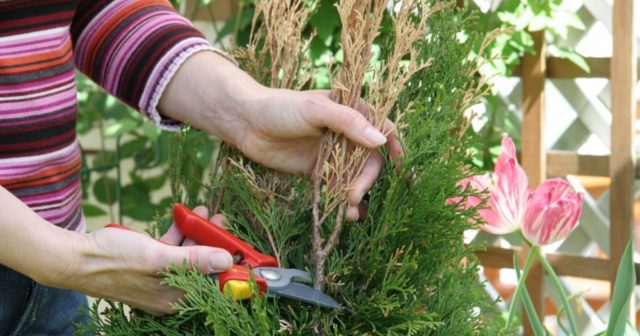

It is possible to fight slugs by installing special traps, which are made of boards or dense material. Dusting with wood ash helps well against the attack of fleas and aphids. If root rot is revealed, then diseased specimens must only be removed, and plants that are more resistant to this type of disease are planted in their place. If affected by powdery mildew, the affected parts should be removed.
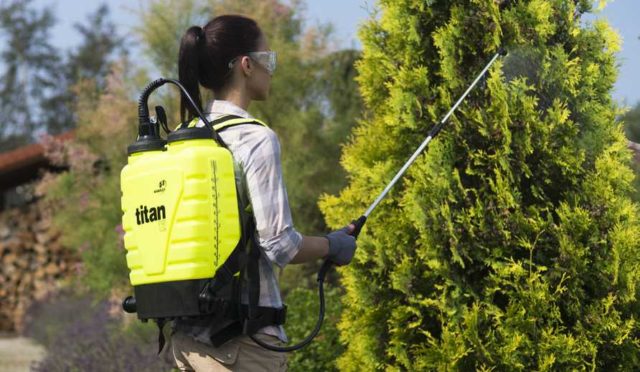

Formative pruning of conifers in a mixborder is carried out both in autumn and spring. Herbaceous plants are shortened to a height of 5-7 cm. If tuberous or bulbous crops are used, they are dug up, and the soil around the shrubs is mulched. For the winter, the flower garden is covered with either spruce branches or oak leaves.
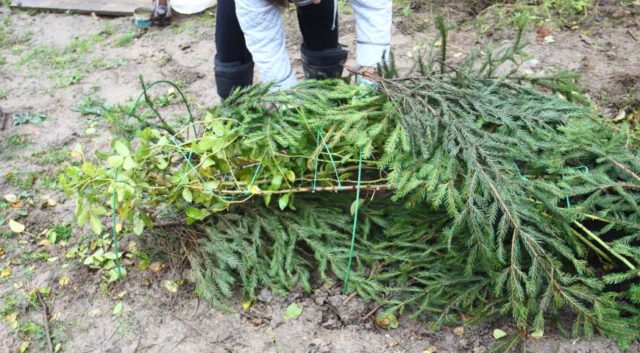

How to choose a plant for composition
Purchase conifers and shrubs from special nurseries or garden stores. But before you buy a seedling, carefully examine it. First of all, the tree must be healthy, without signs of diseases and pests, as well as damage to the needles and crown. It is advisable to purchase plants grown in containers. In this case, they can be planted at any time of the year. Many nurseries also sell them in burlap or wire mesh. These plants can also be purchased safely. But if you are offered a copy with open roots, on which there is no earthy coma, then it is better to refuse to purchase. Most likely, the plant will not take root.
Coniferous seedlings are a rather expensive pleasure, and at a young age, trees and shrubs of different species are so similar that only specialists can distinguish them. Therefore, in order not to be mistaken with the plant, before going to the store, arm yourself with a catalog with a description and a photo.
Choose varieties that are regionalized for your climatic conditions.In the middle lane, the following conifers take root well:
- Cossack, Virginian, rocky, Chinese juniper;
- prickly and European spruce;
- mountain, black and common pine;
- thuja western;
- Kemfer larch;
- yew berry;
- fir and cypress.
And this is not a complete list. In general, from the whole variety of conifers, you will always find a specimen that fits perfectly into the landscape.
Compositions of conifers and perennials, photos of which are presented in the article, will decorate your site. And caring for this beauty does not take much time and effort. The main thing is to choose a good place for the plants and provide them with minimal care, and then they will please with an attractive appearance and rapid growth.

